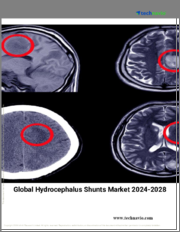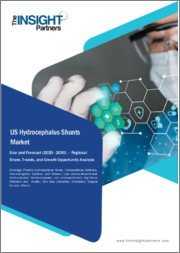
|
시장보고서
상품코드
1528602
수두증 션트 시장 : 제품별, 시술별, 연령대별, 최종 용도별, 세계 예측(2024-2032년)Hydrocephalus Shunt Market - Product (Valves [Adjustable, Fixed], Catheters), Procedure (Ventriculoperitoneal, Lumboperitoneal, Ventriculoatrial, Ventriculopleural), Age Group (Pediatric, Adult), End Use (Hospitals, ASCs), Global Forecast (2024 - 2032) |
||||||
수두증 션트 시장 규모는 수두증 및 관련 신경 질환의 유병률 증가에 힘입어 2024년부터 2032년까지 연평균 3.5%의 성장률을 기록할 것으로 예상됩니다.
보고서에 따르면 전 세계적으로 연간 약 40만 명의 어린이가 수두증 진단을 받고 있습니다. 수두증은 선천성 및 후천성 모두 증가 추세에 있으며, 특히 소아 및 노인의 수두증 증가는 션트 장치에 대한 수요를 증가시키고 있습니다. 진단 기술의 발전과 의료진의 인식 개선도 조기 발견 및 조기 치료에 기여하고 있습니다.
최신 수두증 션트는 생체 적합성, 신뢰성 및 사용 편의성을 향상시키기 위해 재료와 메커니즘이 개선되었습니다. 또한, 프로그래밍 가능한 밸브와 원격 모니터링 기능과 같은 혁신적인 기술은 환자의 예후와 편의성을 개선하여 의료 전문가에게 더욱 매력적인 장비가 되고 있습니다. 션트 기술 개선과 응용 분야 확대를 위한 연구개발 노력이 증가하면서 시장 성장에 박차를 가할 것으로 보입니다.
산업은 제품 유형, 시술 유형, 연령대, 최종 용도, 지역으로 구분됩니다.
제품별로 보면 수두증 션트 시장은 2032년까지 수두증 카테터 부문이 그 효과와 기능성으로 인해 큰 성장률을 기록할 것으로 예상됩니다. 또한, 카테터 기술의 발전으로 재료의 개선과 디자인 혁신으로 생체 적합성이 향상되고 합병증 위험이 감소함에 따라 카테터 채택이 확대될 것으로 예상됩니다.
요추복강 션트는 기존의 뇌실복강 션트가 적합하지 않은 질환을 관리하는 데 효과적이기 때문에 2024년부터 2032년까지 큰 수익을 창출할 것으로 예상됩니다. 요추복막(LP) 션트는 뇌척수액을 허리에서 복강으로 우회시킬 수 있어 체액 관리에 대한 또 다른 접근 방식을 제공하며, 복잡한 환자들에게 유용한 대안이 되고 있습니다.
아시아태평양의 수두증 션트 산업은 의료 인프라의 급속한 개선과 의료 기술에 대한 투자 증가로 인해 2032년까지 상당한 CAGR로 성장할 것입니다. 여러 국가가 의료 시스템을 강화하고 고급 치료에 대한 접근성을 확대함에 따라 수두증 환자를위한 전문 치료에 더 쉽게 접근 할 수 있습니다. 의료 시설을 개선하고 치료 비용을 보조하기 위한 정부의 노력과 의료 정책도 이 지역의 시장 성장을 촉진하고 있습니다.
목차
제1장 조사 방법과 조사 범위
제2장 주요 요약
제3장 업계 인사이트
- 생태계 분석
- 업계에 대한 영향요인
- 성장 촉진요인
- 선천성 수두증 유병률 증가
- 수두증 외과 치료에 대한 인식 확산
- 수두증 치료에 대한 상환 제도 이용 가능성
- 노인 인구 증가
- 업계의 잠재적 리스크와 과제
- 신흥 국가의 복잡한 신경외과 수술 인프라 부족
- 수두증 션트 수술과 팔로업 케어에 따른 고비용
- 성장 촉진요인
- 성장 가능성 분석
- 규제 상황
- Porters 분석
- PESTEL 분석
제4장 경쟁 상황
- 소개
- 기업 점유율 분석
- 기업 매트릭스 분석
- 경쟁 포지셔닝 매트릭스
- 전략 대시보드
제5장 시장 추정과 예측 : 제품 유형별, 2021-2032년
- 주요 동향
- 수두증 밸브
- 압력 조정 가능 밸브
- 고정 압력 밸브
- 수두증 카테터
- 표준 카테터
- 항균 카테터
제6장 시장 추정과 예측 : 시술 유형별, 2021-2032년
- 주요 동향
- 뇌실복강
- 요추복강
- 뇌실심방
- 뇌실흉강
제7장 시장 추정과 예측 : 연령층별, 2021-2032년
- 주요 동향
- 소아
- 성인
제8장 시장 추정과 예측 : 최종 용도별, 2021-2032년
- 주요 동향
- 병원
- 외래 수술 센터
제9장 시장 추정과 예측 : 지역별, 2021-2032년
- 주요 동향
- 북미
- 미국
- 캐나다
- 유럽
- 독일
- 영국
- 프랑스
- 스페인
- 이탈리아
- 네덜란드
- 기타 유럽
- 아시아태평양
- 중국
- 일본
- 인도
- 호주
- 한국
- 기타 아시아태평양
- 라틴아메리카
- 브라질
- 멕시코
- 기타 라틴아메리카
- 중동 및 아프리카
- 남아프리카공화국
- 사우디아라비아
- 아랍에미리트
- 기타 중동 및 아프리카
제10장 기업 개요
- B. Braun Melsungen AG
- CHRISTOPH MIETHKE GMBH & CO. KG
- DESU MEDIKAL A.S.
- G. Surgiwear Ltd.
- Hpbio
- Integra LifeSciences Corporation
- Kaneka Medix Corp.
- Luciole Medical AG
- Medtronic plc
- Natus Medical Incorporated
- SOPHYSA
- TKB Corporation
Hydrocephalus shunt market size is likely to register a 3.5% CAGR from 2024-2032 driven by the increasing prevalence of hydrocephalus and related neurological conditions. As per reports, annually around 400,000 children worldwide are diagnosed with hydrocephalus. The rising incidence of hydrocephalus, including both congenital and acquired forms, particularly in pediatric and elderly populations, is boosting the demand for shunt devices. Advances in diagnostic techniques and increased awareness among healthcare providers will also contribute to earlier detection and treatment.
Modern hydrocephalus shunts feature enhanced materials and advanced mechanisms for better bio-compatibility, reliability, and ease of use. Innovations, such as programmable valves and remote monitoring capabilities are also offering improved patient outcomes and convenience, making these devices more attractive to healthcare professionals. Increased R&D efforts aimed at refining shunt technologies and expanding applications will add to the market growth.
The industry is segmented into product, procedure type, age group, end-use, and region.
Based on product, the hydrocephalus shunt market from the hydrocephalus catheters segment will record a significant growth rate through 2032 due to their effectiveness and functionality. Advancements in catheter technology, such as improved materials and design innovations are also enhancing bio-compatibility and reducing the risk of complications, further contributing to their increasing adoption.
Hydrocephalus shunt market from the lumboperitoneal procedure type segment is poised to generate substantial revenue between 2024 and 2032 owing to their effectiveness in managing conditions where traditional ventriculoperitoneal shunts are less suitable. The ability of lumboperitoneal (LP) shunts to divert cerebrospinal fluid from the lumbar region to the peritoneal cavity provides an alternative approach to fluid management, making them a valuable option in complex cases.
Asia Pacific hydrocephalus shunt industry size will grow at a substantial CAGR through 2032 attributed to the rapidly improving healthcare infrastructure and increased investments in medical technologies. As several countries are enhancing their healthcare systems and expanding access to advanced treatments, there is greater availability of specialized care for hydrocephalus patients. Government initiatives and healthcare policies aimed at improving medical facilities and subsidizing treatment costs will also help in driving the regional market growth.
Table of Contents
Chapter 1 Methodology & Scope
- 1.1 Market scope & definitions
- 1.2 Research design
- 1.2.1 Research approach
- 1.2.2 Data collection methods
- 1.3 Base estimates & calculations
- 1.3.1 Base year calculation
- 1.3.2 Key trends for market estimation
- 1.4 Forecast model
- 1.5 Primary research and validation
- 1.5.1 Primary sources
- 1.5.2 Data mining sources
Chapter 2 Executive Summary
- 2.1 Industry 360° synopsis
Chapter 3 Industry Insights
- 3.1 Industry ecosystem analysis
- 3.2 Industry impact forces
- 3.2.1 Growth drivers
- 3.2.1.1 Increasing prevalence of congenital hydrocephalus
- 3.2.1.2 Growing awareness towards surgical treatment of hydrocephalus
- 3.2.1.3 Availability of reimbursement coverage for hydrocephalus treatments
- 3.2.1.4 Increasing geriatric population
- 3.2.2 Industry pitfalls & challenges
- 3.2.2.1 Lack of infrastructure for performing complex neurosurgeries in emerging countries
- 3.2.2.2 High cost associated to hydrocephalus shunt surgery and follow-up care
- 3.2.1 Growth drivers
- 3.3 Growth potential analysis
- 3.4 Regulatory landscape
- 3.5 Porter's analysis
- 3.6 PESTEL analysis
Chapter 4 Competitive Landscape, 2023
- 4.1 Introduction
- 4.2 Company market share analysis
- 4.3 Company matrix analysis
- 4.4 Competitive positioning matrix
- 4.5 Strategy dashboard
Chapter 5 Market Estimates and Forecast, By Product type, 2021 - 2032 ($ Mn)
- 5.1 Key trends
- 5.2 Hydrocephalus valves
- 5.2.1 Adjustable pressure valves
- 5.2.2 Fixed pressure valves
- 5.3 Hydrocephalus catheters
- 5.3.1 Standard catheters
- 5.3.2 Antimicrobial catheters
Chapter 6 Market Estimates and Forecast, By Procedure type, 2021 - 2032 ($ Mn)
- 6.1 Key trends
- 6.2 Ventriculoperitoneal
- 6.3 Lumboperitoneal
- 6.4 Ventriculoatrial
- 6.5 Ventriculopleural
Chapter 7 Market Estimates and Forecast, By Age group, 2021 - 2032 ($ Mn)
- 7.1 Key trends
- 7.2 Pediatric
- 7.3 Adult
Chapter 8 Market Estimates and Forecast, By End-use, 2021 - 2032 ($ Mn)
- 8.1 Key trends
- 8.2 Hospitals
- 8.3 Ambulatory surgery centers
Chapter 9 Market Estimates and Forecast, By Region, 2021 - 2032 ($ Mn)
- 9.1 Key trends
- 9.2 North America
- 9.2.1 U.S.
- 9.2.2 Canada
- 9.3 Europe
- 9.3.1 Germany
- 9.3.2 UK
- 9.3.3 France
- 9.3.4 Spain
- 9.3.5 Italy
- 9.3.6 Netherlands
- 9.3.7 Rest of Europe
- 9.4 Asia Pacific
- 9.4.1 China
- 9.4.2 Japan
- 9.4.3 India
- 9.4.4 Australia
- 9.4.5 South Korea
- 9.4.6 Rest of Asia Pacific
- 9.5 Latin America
- 9.5.1 Brazil
- 9.5.2 Mexico
- 9.5.3 Rest of Latin America
- 9.6 Middle East and Africa
- 9.6.1 South Africa
- 9.6.2 Saudi Arabia
- 9.6.3 UAE
- 9.6.4 Rest of Middle East and Africa
Chapter 10 Company Profiles
- 10.1 B. Braun Melsungen AG
- 10.2 CHRISTOPH MIETHKE GMBH & CO. KG
- 10.3 DESU MEDIKAL A.S.
- 10.4 G. Surgiwear Ltd.
- 10.5 Hpbio
- 10.6 Integra LifeSciences Corporation
- 10.7 Kaneka Medix Corp.
- 10.8 Luciole Medical AG
- 10.9 Medtronic plc
- 10.10 Natus Medical Incorporated
- 10.11 SOPHYSA
- 10.12 TKB Corporation


















